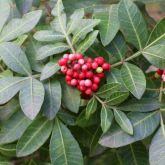Broad-leaved pepper tree

Broad-leaved pepper tree leaf and fruit
© Queensland Government

Broad-leaved pepper tree flower and leaf
© Queensland Government

Broad-leaved pepper tree fruit
© Queensland Government

Broad-leaved pepper tree plant
© Queensland Government
Native to South America, broad-leaved pepper tree is a large, spreading tree. In Australia, it has escaped gardens and invaded coastal dune lands, wetlands and streambanks. It also out-competes and replaces native grasses used in grazing, and can harbour mango black spot disease and witches' broom diseases that affect citrus. Broad-leaved pepper tree is common in many habitats in South East Queensland.
You must manage the impacts of broad-leaved pepper tree on your land.
You must not give away, sell or release broad-leaved pepper tree into the environment.
Scientific name
Description
- Broad, spreading tree up to 10m tall.
- Leaves are dark green, consist of 5–9 leaflets, 4–12 opposite pairs.
- Flowers are small, whitish, growing at end of branches.
- Fruits are red, bunched, glossy, round, 6mm across.
- Berries are 4–5mm wide, containing 1 seed.
- Leaves and berries have pepper smell when crushed.
- Not all trees bear fruit.
Habitat
- Prefers coastal dune areas, wetlands, streambanks.
Distribution
- Visit the Weeds Australia website and click on the distribution tab to access the distribution map.
Life cycle
- Reproduces from 3 years old.
- Can live up to 35 years.
- Flowers mainly in autumn but can flower year-round.
Affected animals
- humans
- grazing stock
- native animals
- birds
Impacts
Economic
- Out-competes and replaces native grasses used in grazing.
Environmental
- Forms dense thickets that can choke native plants.
- Establishes in disturbed bushland.
- Competes with ground covers and shrubs and tolerates shade.
- Spreads rapidly in waterlogged or poorly drained soils.
Social
- Contains toxic resins that can affect human and animal health.
How it is spread
- Berries spread by birds and animals.
Prevention
Control
Physical control
- Hand-pull or chip out young plants.
- Remove trees in winter.
- Felled trees may regrow from suckers for up to 18 months. If chopping, mulch branches, especially if trees have seed. Alternatively, cut trees 5cm below soil, chip away bark and nail tin plate over stump.
Herbicide control
- Herbicides are available using foliar application, basal bark and cut-stump methods.
Read the broad-leaved pepper tree fact sheet (PDF, 7.3MB) for herbicide control and application rates.
Legal requirements
- Broad-leaved pepper tree is a category 3 restricted invasive plant under the Biosecurity Act 2014.
- You must not give away, sell, or release into the environment. Penalties may apply.
- You must take all reasonable and practical measures to minimise the biosecurity risks associated with dealing with broad-leaved pepper tree under your control. This is called a general biosecurity obligation (GBO).
- At a local level, each local government agency must have a biosecurity plan that covers invasive plants in its area. This plan may include actions to be taken on broad-leaved pepper tree. Some of these actions may be required under local laws. Contact your local council for more information.